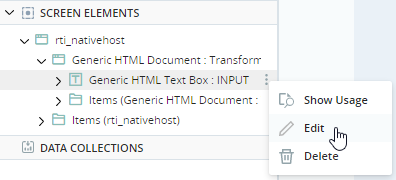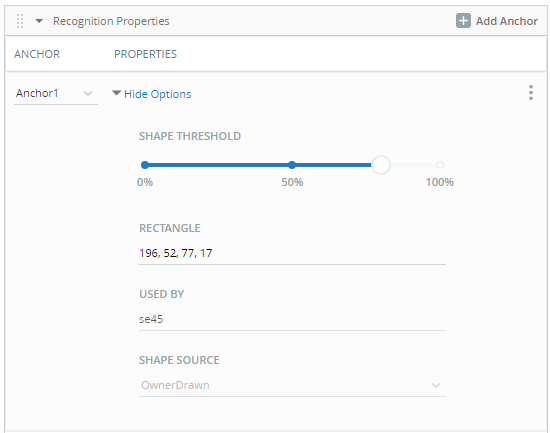Edit an IBA Element
The Screen Elements tab allows you to specify how a specific screen element should be treated and identified during run-time.
This topic explains how to edit an IBA element. For screen elements captured using connectors, see Edit a Screen Element.
Open the Screen Elements Tab
The Screen Elements tab is displayed automatically after capturing an IBA element.
To open the Screen Elements tab at any other time, either:
-
Hover over the screen element you want to edit, click the Menu button
 , and click Edit.
, and click Edit. -
Click the Screen Elements tab below the Assets Panel.
View the Element Hierarchy
The Element Hierarchy is displayed at the left of the Screen Elements tab.
The hierarchy is as follows:
-
The application
-
(Other elements depending on the application)
-
The frame in which the captured IBA element is located
-
The captured IBA element
-
-
-
From the hierarchy, you can:
-
Click any element to view and edit its details.
-
Click the menu button
 and then either delete the element or open the Usage Reference Panel for a list of all places where the element is used in the project.
and then either delete the element or open the Usage Reference Panel for a list of all places where the element is used in the project.
Name the IBA Element
The captured IBA element is assigned a name automatically.
You should change the name to a name you will be able to recognize in your project.
View the IBA Element Type and ID
The IBA element type and ID are set when you first capture the element and cannot be changed afterward.
Test an IBA Element
You can check whether a captured IBA element can be correctly identified.
Any item in a captured IBA element's hierarchy can be located, except for the application (top) level.
To test a screen element:
-
Make sure that the application from which the screen element was captured is open, and that the screen element is displayed.
-
Click Verify.
If the element can be recognized, the relevant window is displayed and the selected element is highlighted. A success message is displayed:
If the element cannot be recognized, for example, if the screen element no longer exists or the recognition properties are not valid, a failure message is displayed:
Set Availability as an Asset
By default, all IBA elements you capture are listed in the Assets Panel and can be used as assets in the project. You can choose to prevent some of the IBA elements from being listed in the Assets Panel and being treated as assets in the project.
For example:
-
To prevent your Assets Panel from becoming cluttered, you may want to remove captured IBA elements that aren't needed although you might not want to delete them completely from your project.
-
When you capture an IBA element, the entire hierarchy of elements is captured as well. If you won't be using those interim elements, you likely won't want them cluttering the Assets Panel.
Whether an IBA element will be listed in the Assets Panel and can be used as an asset depends on the Available as an Asset setting.
When set to Off:
-
The IBA element will not be listed in the Assets Panel and cannot be used as an asset.
-
The IBA element will continue to be displayed in the hierarchy on the Screen Elements tab but will be displayed as disabled.
If the IBA element is already in use as an asset, Available as an Asset can still be turned off. However, this will result in an error wherever the asset is used.
-
The Destroy and Refresh method of the NICE_Search_Field IBA element is used in the workflow below.

-
If the NICE_Search_Field IBA element is set to not be available, an error message is shown in place of the Destroy and Refresh method.

Set an IBA Element's Recognition Properties
During run-time (and when verifying), an IBA element is recognized not only by its own appearance, but also by its relative location to other items in the frame called anchors. Anchors can either be:
-
Other elements (e.g. buttons, text fields, images, or banners)
-
The physical edges or corners of the window in which the IBA element is located.
It is recommended that at least one anchor be associated with each IBA element. Although an IBA element may be recognized without any anchors, having anchors associated with IBA elements substantially improves performance.
There is usually no need to add new anchors or to edit the anchors that were captured automatically.
When you capture an IBA element, one anchor is automatically captured and assigned to the IBA element.
An IBA element's anchors are managed in the Recognition Properties panel.
In the Recognition Properties panel, you can:
-
Add an anchor
Click
 to add a new line to the Recognition Properties panel.
to add a new line to the Recognition Properties panel. -
Specify which anchor to use as a recognition property
Select an anchor from the drop-down list.
The drop-down list includes only anchors defined for the frame in which the IBA element is located and the edges of the window in which the IBA element is located. New anchors can be added to a frame and they will then be listed for selection as anchors for all IBA elements in the frame.
The drop-down list is automatically filtered to show only those anchors not already selected as anchors for the IBA element.
-
Remove an anchor
Remove an anchor from the menu
 .
. -
Modify anchor options
You can modify the settings for each anchor assigned to the IBA element.
No options are available for window edge anchors.
The following options are available for anchors:
Option
Description
Shape Threshold
Specify the recognition threshold for the anchor. If the anchor cannot be recognized, try adjusting this value downward.
Use Frame Identification If not checked, the anchor is looked up at run-time but does not affect the frame identification - if the anchor is not found the frame is still identified. Rectangle
The coordinates of the rectangle around the element are displayed in the following format:
X-position of top-left corner, Y-position of top-left corner, width, height
These values can only be modified for anchors and for IBA elements that are owner drawn (i.e., IBA elements that were not automatically surrounded by a blue rectangle during capture, for which the developer had to manually draw their outline). The anchor shown in the Screenshot panel is repositioned when you change the rectangle coordinates.
These values cannot be modified for shape recognized elements (i.e., IBA elements that were automatically surrounded by a blue rectangle during capture).
Shape Source
(Read-Only) Indicates the source of the shape of the anchor:
-
Owner Drawn: The shape of the anchor was drawn by the developer because its outline was not automatically detected during capture. (Anchors are classified as owner drawn.)
-
Shape Recognized: The shape of the anchor was identified automatically during capture.
-
Changes to an anchor's options are applied for all IBA elements that use the anchor.
Set an IBA Element's Options
The Options panel lists all options available for the IBA element. The options listed depend on the IBA element type.
Descriptions of all options available for each IBA element type are provided here.





















